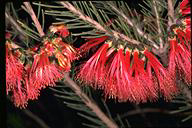

 |
Australian National Botanic Gardens
|
 |
A weekly news sheet prepared by a Gardens' volunteer.
Numbers in square brackets [] refer to garden bed Sections.
Plants in flower are in bold type.
21 October 2005
 |
|
Micromyrtus ciliata - click for larger image |
It's now 35 years since the Australian National Botanic Gardens opened to the public and this week's walk includes areas originally planted with specimens from the Myrtaceae and Proteaceae families.
Following the bitumen road, at the junction with the main path, Micromyrtus ciliata [Section 12] has minute white flowers ageing to red and will give a continuous display for many months. On the right Grevillea aquifolium [Section 143] has interesting grey-green holly-like leaves and soft profuse pink flowers. Opposite a lovely specimen of Calothamnus quadrifidus [Section 12] displays showy red flowers amongst soft pine-like leaves. On the right are several low-growing Grevillea juniperina [Section 143] with bright red flowers and spiky leaves. Many of the old Tea Trees and Paperbarks along the walk have beautiful trunks and it is a nice, peaceful area. Some Leptospermum sericatum [Section 12] on the left are bright with white flowers. At the corner, opposite a picnic area, look up to see dull red flowers on two clumps of Box Mistletoe Amyema pendula [Section 12] growing on a Eucalyptus mannifera .
 |
Calothamnus quadrifidus - click for larger image |
Turn left onto a dirt path and admire Pomaderris pauciflora [Section 31] covered with small leaves and clusters of cream flowers. On the right Kunzea parvifolia [Section 11] has lots of fluffy mauve flowers. Turning right past some rocks, notice large clusters of golden-yellow button flowers on Chrysocephalum semipapposum [Section 29], nestled under a large Eucalyptus parramattensis .
After a left and then a right turn, join a winding path to the left of a Section 28 sign. Just past a large eucalypt, Grevillea phillipsiana [Section 27] has fine leaves and spiky red flowers. Then a prostrate Grevillea confertifolia [Section 27] has profuse clumps of raspberry-pink flowers. A venerable Grevillea victoriae var. leptoneura [Section 27] leans along the ground—its base is a Cryptogam monitoring site for mosses and liverworts. On the right Banksia ericifolia var. ericifolia [Section 28] has large orange flower spikes, while at the corner Banksia occidentalis [Section 28] has conspicuous gold flowers tinged with red. Grevillea oleoides [Section 27] has large clusters of pink-red spider-like flowers. Banksia integrifolia subsp. compar [Section 28] is a large tree with profuse spikes of bright creamy-lemon flowers. The large Grevillea ‘Sid Reynolds' [Section 25] is dazzling with profuse cream and pink flowers. Back on a bitumen road, it is easy to see why Hakea corymbosa [Section 25], with its rigid prickly leaves and greenish flowers, is commonly called the Cauliflower Hakea.
There is much more to see including the tropical glasshouse. Or you can turn left or right to follow a different path and enjoy more wonderful spring flowers.
Kath Holtzapffel